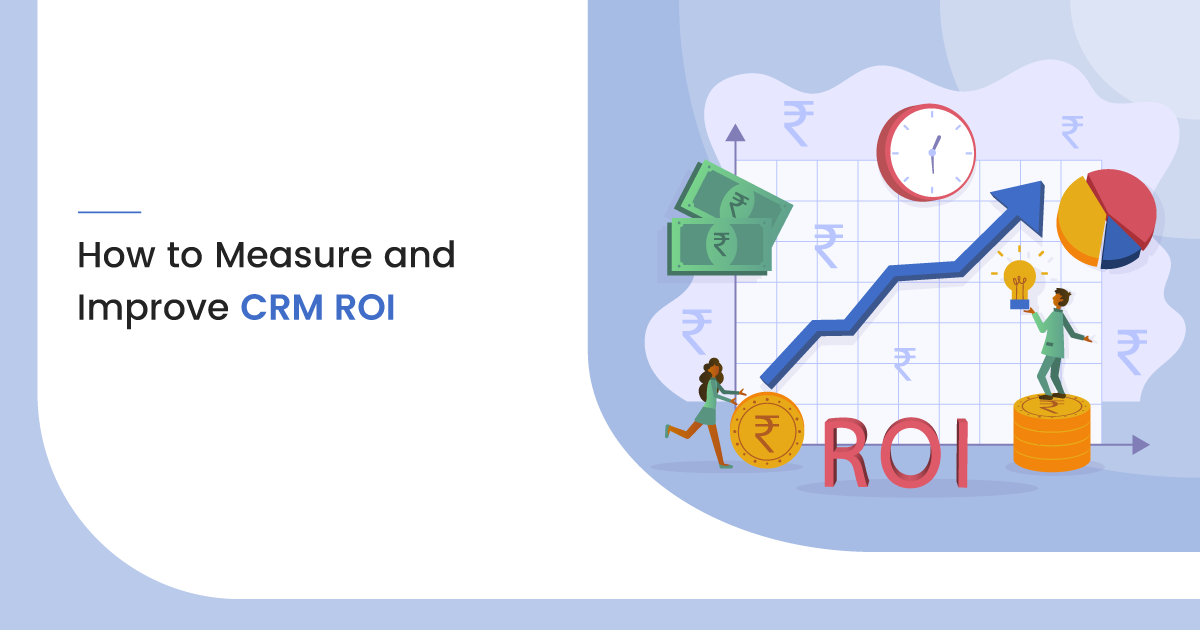Customer service and relationship management is undoubtedly an integral component of every business. When a business fosters its relationship with its existing customers, it enhances customer lifetime value, which, in turn, uplifts the profits.
Furthermore, retaining an existing customer is much economical than acquiring new customers. Even studies second that. According to a study, the cost of customer acquisition is five times the investment in customer retention.
So, what’s the best way to retain your customers? Well, it’s surely by working towards the management of customer relationships. However, the task of CRM can be cumbersome when handled manually. So, you should invest in CRM software.
Now, let’s delve more into how you can implement CRM tools in your business and how to measure and improve CRM ROI.
What is customer relationship management?
Customer relationship management or CRM systems help businesses to organize customers’ data and information in a single place so that they can effectively utilize it to provide exceptional customer service.
With a multitude of benefits like storing customer information, integrating marketing automation, offering predictive analytics, CRM helps your sales team to monitor and manage accounts, upsell current customers, secure new business; to name a few.
The importance of CRM can be identified from the fact that companies, on average, earn more than $8.71 for every dollar spent on the implementation of CRM, as per the study by Nucleus Research in 2014.
Let’s take a look at some of the key insights and stats on CRM ROI to get the most out of your CRM to drive sales success.
- Companies using CRM have witnessed more than 12% of improvements in their overall sales figure.
- Nearly 90% of organizations are happy with CRM results and likely to use it for a longer time.
Hence, there’s no denying that the value of such systems does play a quintessential role to cater to your business needs.
But things get tangled a bit when it becomes cumbersome to measure the return on investment or ROI.
And for that, you must consistently monitor the performance of your CRM solution. By doing so, you’ll get an idea of adjustments and improvements to be made.
Let’s have a look at some tips to track the return on investment of your CRM solution and to improve CRM ROI.
Tips to Measure & Improve the ROI of Your CRM
Here are tips to measure CRM ROI and make the most out of your investment.
-
Think What to Track to Measure CRM RoI
When it comes to measuring the ROI of your CRM solution, you must prioritize the metrics that you will track to start things off and measure the right performance.
One of the most popular sales consultants, Paul McCord suggested six key metrics that will help you to measure CRM’s ROI.
The first and foremost metric is to monitor the number of sales-related calls made in a day. The calls must include both incoming and outgoing, this will give you a clear picture of how’s the sales activity going on.
If you want to make this trick successful, however, you must track the number of sales made by each sales call.
Incorporating these two metrics will help you know how much effort your team needs to put in to achieve your respective organizational objectives.
Another important metric that’s incredibly important is to efficiently track the duration of your sales cycle. This will let you know the time that it takes once your team member contact with a prospect to make a sale. By tracking so, you’ll likely to monitor cash flow that’s imperative for the financial management of your company.
The fourth and fifth metric to predict the return on investment and cash flow are average value per consumer and upsell rates for customers that are currently in contact.
The sixth and last metric is nothing but the client retention rate. This will tell you the effort you need to put in for marketing activities to maintain your existing customer base. Furthermore, this will let you know the expenses related to your influencer marketing strategies.
There are other metrics you can track besides these, but starting with these six will give you a good foundation for measuring your CRM return on investment.
-
Compare Your Baseline to Your Performance and Your Expenses
After getting all the data and information you want to track, you have got the basis for measuring CRM ROI.
You must establish a baseline to convert the tracked numbers into CRM ROI measurement. To start things, you must use numbers generated by your old sales system to establish your baseline.
If this data, unfortunately, is unavailable, you can take a baseline from current performance and track how the implementation of your CRM solution would affect your overall sales figure.
When you compare your baseline with the current performance of your organization, you can examine how your CRM solution is substantially affecting your key metrics and your revenue generation process.
When you compare this with the cost you incur for your CRM, you can easily find out your return on investment.
Remember that the ROI you get from your CRM solution is highly dependent on what you incorporate into it.
By making significant modifications and adjustments, you can improve your CRM ROI to an unprecedented scale.
When it comes down to improving your CRM performance, you can leverage several strategies.
One of them is using your CRM data to analyze your existing customers so that you can improve your marketing activities to get fruitful results. When you share your CRM data with your marketing team, you can solely emphasize on other promotional campaigns, especially on those consumers who are more likely to purchase from you. This would significantly increase your sales conversion rate and the efficiency of your sales calls to sales ratio.
By using your CRM tool, you may increase your sales conversion rate to automate the steps involved in the process of your sales.
Let’s take an example to understand…
You can make the best use of CRM analytics to find out most active prospects and then alerts would be sent to your sales team, indicating them the customers they must target to increase their sales. Furthermore, you may create a process for setting up follow-up contracts with potential buyers and have reminders sent out whenever you feel it’s the right time to follow-up.
These are just a few of the advanced techniques of CRM tools that would help you improve your ROI.
Always keep this in mind that, “the more expertise your sales team has in how to operate your CRM software, the more chances that you’ll get a better return on investment”.
To gain chockfull customers and drive substantial sales, you must focus on hiring professionals with relevant experience in your specific CRM. Doing so will help you maximize the ROI of your customer relationship management software.
Final Thoughts
Choosing the right metric to track is the initial step towards measuring the ROI of your CRM. After that, you can establish a baseline (as discussed above) for comparison with the performance of your CRM and later compare the result with your expenses to determine ROI.
By using these advanced metrics, you can improve your CRM ROI and make effective adjustments to influence your CRM software and highly optimize your sales performance.
Need Any Technology Assistance? Call Pursho @ 0731-6725516




